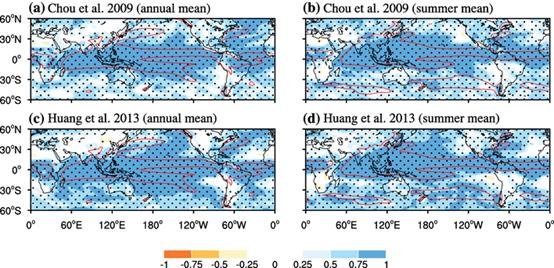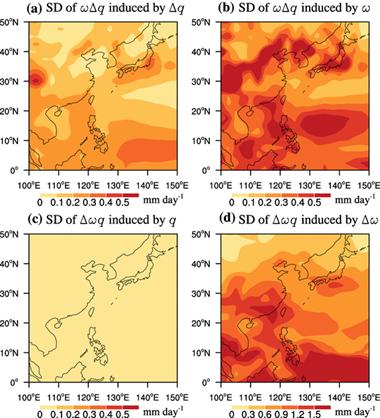State Key Laboratory of Numerical Modeling for Atmospheric Sciences and
Geophysical Fluid Dynamics (LASG)
Institute of Atmospheric Physics, Chinese Academy of Sciences

Vol. 6/No.6 July 2018
[Climate change] Changes in the East Asian summer monsoon rainfall under globalwarming: moisture budget decompositions and the sources of uncertainty
East Asian summer monsoon, as one of the most important global monsoon systems, provides most of therainfall for China, Korea and Japan. Under global warming, the changes in the intensity, frequency and seasonal cycle of the EASM are crucial to the health and food safety for people living in East Asia.
Recently, Dr. Zhou Shijie, Prof. Huang Gang and Prof. Huang Ping from the Institute of Atmospheric Physics (IAP) of the Chinese Academy of Sciences established anapproach to evaluate the applicability of the moisture budget decompositions to the EASM rainfall changes and compared the applicability of two complete moisture budget decompositions and one simplified moisture budget decomposition by using this method. Then, the simplified moisture budget decomposition wasapplied to investigate the sources of intermodel uncertainty of the EASM rainfall changes.
Results of the study indicate that the applicability of the simplified moisture budget decomposition is very close to that of the complete moisture budget decomposition. In addition, this simplified moisture budget decomposition provides an efficient way to study the various aspects of the EASM rainfall changes. By analyzing the intermodel standard deviation and signal-to-noise ratio, they conclude that the EASM circulation changes are the largest source of the intermodel uncertainty of the EASM rainfall changes. On the other hand, the background circulation is also an important source of the intermodel uncertainty of the EASM rainfall changes.As the background circulationof model can be compared with observations, the resultimplies that the observational constraint method is potentialto correct the intermodel spread of the thermodynamiccomponent in the EASM rainfall changes.

Figure 1. The applicability of different moisture budget decompositions (shaded). (a,c) are the results of the annual mean, (b,d) are the results of the summer mean. Red curves are the 4 mm day–1 contour of the climatological rainfall. Stippling indicates where the correlation coefficient passes the student t test at the 95% confidence level.

Figure 2. The SD of the thermodynamic (-wD q) components contributed by the SD of (a) Dq and (b)w . The SD of the dynamic (–wD q) components contributed by the SD of (c) q and (d) wD. Note that the color bar in (d) differs from the others.
Citation:
Zhou, S., G. Huang, and P. Huang, 2017: Changes in the East Asian summer monsoon rainfall under global warming: Moisture budget decompositions and the sources of uncertainty. Climate Dyn., doi:10.1007/s00382-017-3959-4.
Link:https://link.springer.com/article/10.1007%2Fs00382-017-3959-4
E-mail: lasg_newsletter@lasg.iap.ac.cn
Editors: Chuanyi Wang (wangcy@lasg.iap.ac.cn), Kangjun Chen(ckj@lasg.iap.ac.cn)